
Grilling a prime rib roast is a flavorful way to elevate a classic cut of meat, whether you’re hosting a special occasion or simply enjoying a weekend cookout.
This guide will walk you through everything you need to know to grill a perfectly tender, juicy prime rib roast, from prepping and seasoning to choosing the right type of prime rib roast to uncovering the differences between each type of grill you can use. We’ll also cover essential tips for storing leftovers and reheating your rib roast, plus a step-by-step recipe that’s easier for beginners to follow.
Should I Use Boneless or Bone-In?
Prime rib roast comes in boneless and bone-in varieties. Generally speaking, bone-in prime rib offers more flavor and insulation during cooking. The bone acts as a natural insulator that helps the meat cook more evenly and retain moisture, resulting in a juicier, more flavorful roast. Some people also love the presentation of a bone-in cut, which is often used in restaurants to enhance the overall aesthetics of a plate. However, bone-in roasts can be trickier to cook evenly, especially for novice grillers, and the bone can make carving the roast more challenging.
Boneless prime rib is easier to handle and cook, overall. Without the bone, the meat cooks faster and more consistently, making it a great option for those who want a more straightforward grilling experience. It’s also much easier to slice, which can be a big advantage if you’re serving a large group. However, some cooks believe the lack of a bone equates to slightly less flavor and juiciness compared to a bone-in prime rib roast.
There’s no wrong choice here. To sum up, a bone-in roast might be better if you want maximum flavor and a more eye-catching appearance. But a boneless prime rib can be much easier to slice and usually shaves some time off the cooking process.
Prepping the Prime Rib
Learn to prep your prime rib to achieve a tender and flavorful result on the grill. In the sections below, discover how to trim and season a prime rib roast before placing it on the grill.
Trimming
When you trim a prime rib roast, you remove excess fat, keeping just enough to add flavor and moisture to the rib roast. To trim the roast, look for the fat cap on the top of the roast. This is a thick slab of fat that covers the top side. Using a sharp knife, trim the fat cap down to about ¼ inch of thickness. If your fat cap is already about this size, there’s no need to trim it down any further.
Next, consider removing the silverskin, or the thin membrane that covers the back of the ribs on a bone-in rib roast. Carefully remove it by sliding a sharp knife underneath the silverskin with one hand and holding the silverskin with your other hand, pulling it away as you continue to slide the knife along the ribs.
Seasoning
After trimming the prime rib roast comes seasoning. This step gives the roast a flavor boost that is enhanced during the grilling process. It’s important to make sure your seasoning reaches the meat instead of just sitting on the surface for flavor in each bite.
To do this, use the tip of a sharp knife to poke several holes into the meat. They don’t need to be large holes; just poke the knife down enough to create small slits for your spice mixture to reach. Next, rub the spice mixture all over the surface of the roast, using your fingertips to press the mixture into the slits you just made. You can also gently press your fingertips along the surface of the roast to help the spice mixture adhere to the meat.
Different Types of Grills to Use
Consider the following types of grills, which are all viable options for grilling prime rib roast.
Charcoal
The classic charcoal grill is still a popular choice because of the flavors it infuses into your food, which are difficult to achieve with other types of grills. Charcoal grills let off a high amount of heat, but if you’re skilled in controlling the airflow of your grill using its built-in vents, you can get a good sear for your prime rib roast while also allowing it to cook over more indirect heat to prevent scorching.
The downside to a charcoal grill is that it can be much more difficult to maintain a consistent temperature, which is what prime rib roast really needs to succeed. It can also take longer to set up and clean compared to a gas grill or pellet grill, as the charcoal typically needs a good amount of time to turn ashy before you can use the grill.
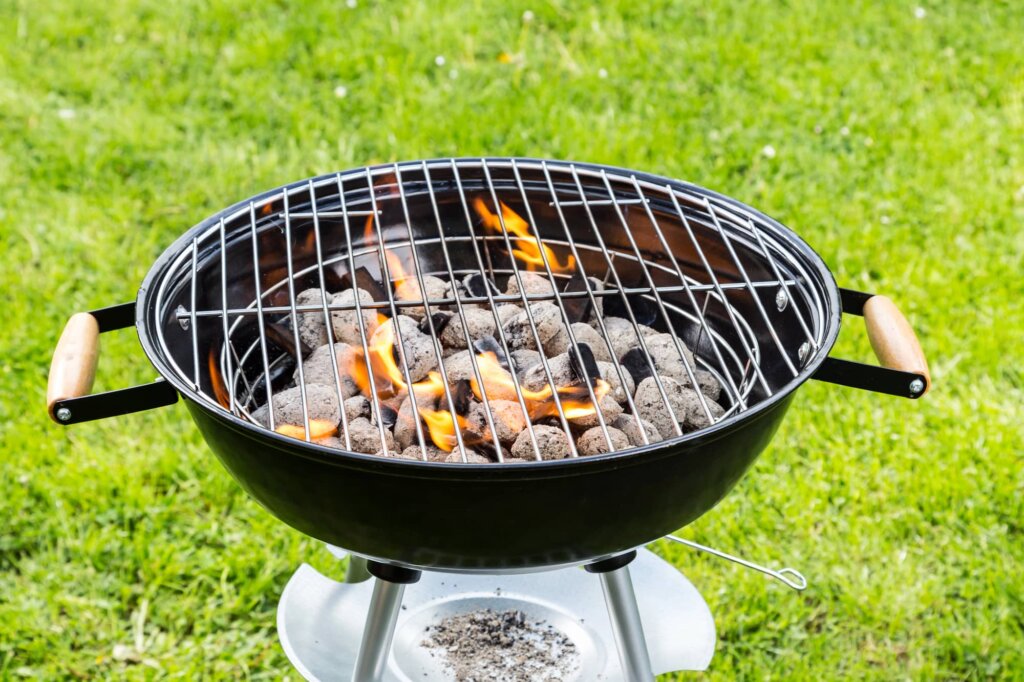
Gas
A gas grill is usually the easiest type of grill to use, as it mimics more of a traditional stove-cooking experience. You can adjust its temperatures easily to keep your prime rib roast cooking at a consistent temperature throughout, and you don’t need to worry about adjusting airflow vents or adding more charcoal to do so.
Of course, without charcoal or wood pellets, gas grills don’t usually provide the same burst of smoky flavor as other grills. But if you’re looking for a more straightforward cook or are grilling prime rib roast for the first time, a gas grill offers somewhat of a foolproof way to accomplish the task.
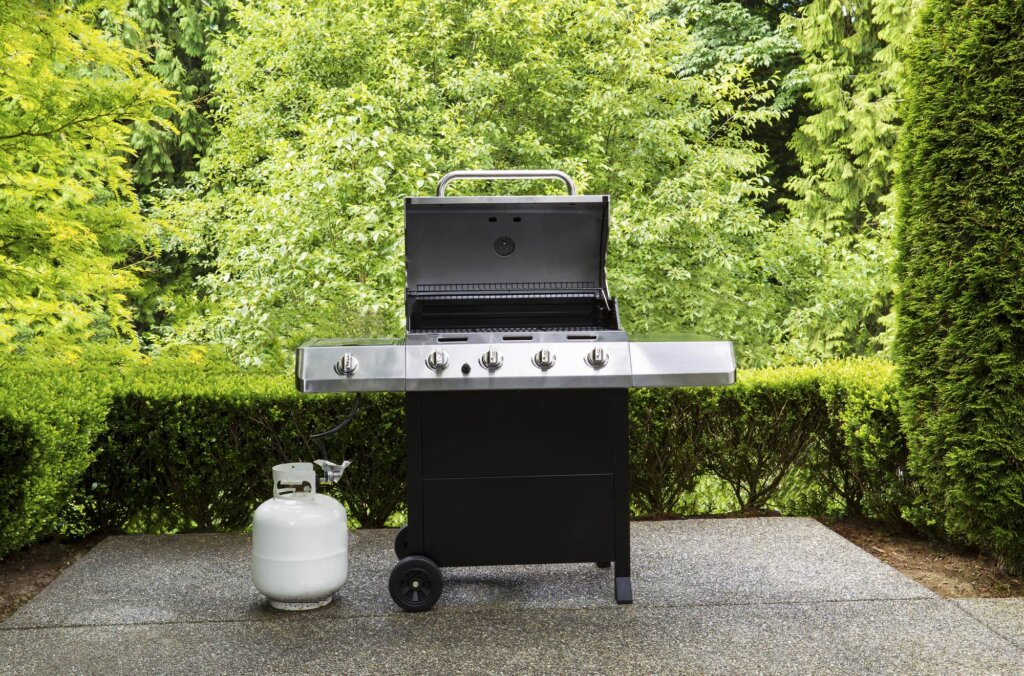
Pellet
Pellet grills are kind of a blend between charcoal and gas grills. They use wood pellets to add smoky flavor to food and fuel the heat inside the grill, but they also have precise temperature control to help you keep your prime rib cooking at a consistent temperature. While you can get true barbecue flavors from a pellet grill, keep in mind that these grills can be more expensive than charcoal and gas grills. Plus, they require a power source to keep them running, so you’ll need to make sure you have an outlet nearby.
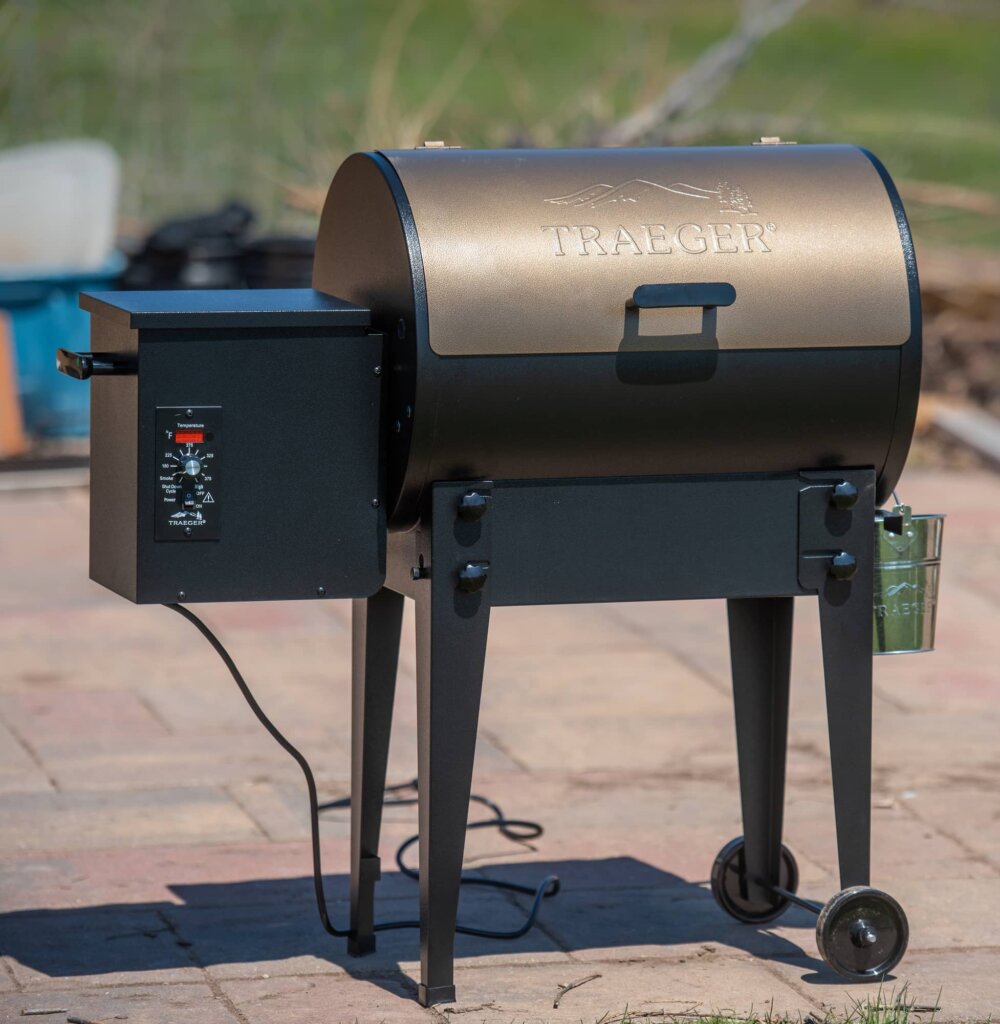
Grilled Prime Rib Roast Recipe
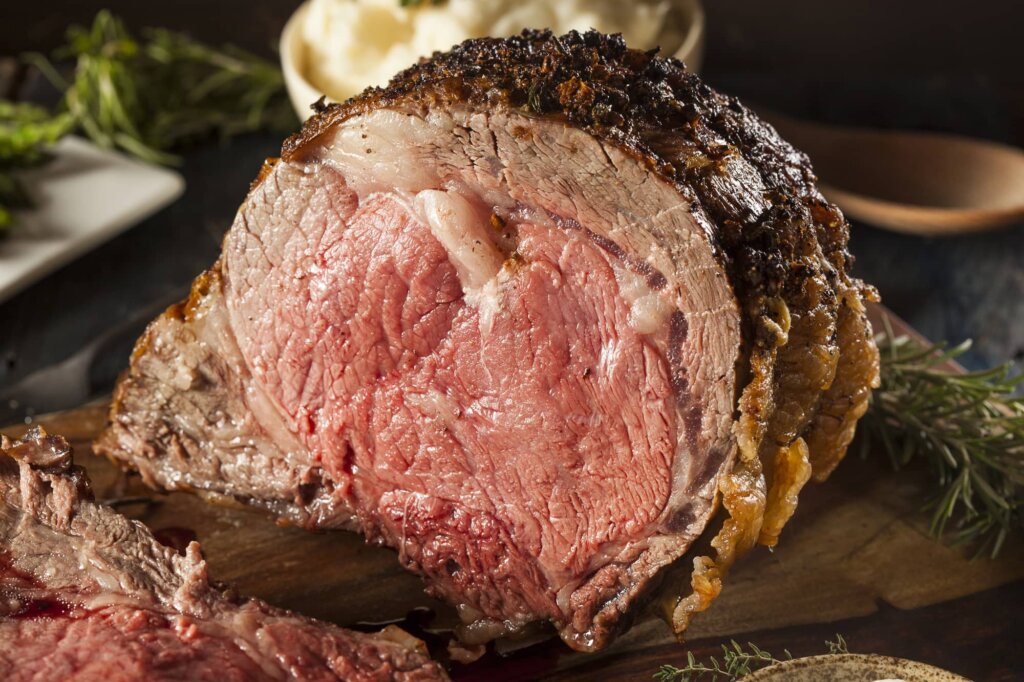
Ingredients
- 4-6-pound bone-in or boneless prime rib roast
- 2 tbsp kosher salt
- 2 tbsp olive oil
- 1 tbsp ground black pepper
- 1 tbsp garlic powder
- 1 tbsp onion powder
- 2 tsp dried rosemary
Instructions
- Trim the prime rib by reducing the fat cap to about ¼ inch thick and removing any silverskin.
- Sprinkle the roast with salt. Leave at room temperature for about 30 minutes.
- Coat the roast with oil, followed by a mixture of the black pepper, garlic powder, onion powder, and rosemary.
- Preheat your grill using indirect heat. If using a charcoal grill, set the coals on one side. For gas or pellet grills, heat to around 250°F.
- Place the roast on the grill over indirect heat. Close the lid and cook for 15-20 minutes per pound, or until the internal temperature reaches 125°F for medium-rare (it will rise in temperature as it rests). Rotate the roast occasionally when cooking to help it cook more evenly.
- Move the roast to direct heat to sear for about 3-5 minutes on each side.
- Rest the roast at room temperature for 15-20 minutes before carving it.
Notes
If possible, use a heat-safe meat thermometer when grilling. You can leave it in the roast throughout the cooking process to continuously monitor its temperature.
Grilled Prime Rib Roast – Nutritional Facts
Per Serving (Based on a 2,000-Calorie Daily Diet)
| Nutrient | Amount (% DV) |
|---|---|
| Calories | 610 |
| Total Fat | 48g (62%) |
| Saturated Fat | 20g (100%) |
| Cholesterol | 145mg (48%) |
| Sodium | 360mg (16%) |
| Total Carbohydrate | 0g (0%) |
| Dietary Fiber | 0g (0%) |
| Sugars | 0g |
| Protein | 42g (84%) |
| Iron | 4.2mg (23%) |
| Vitamin C | 0mg (0%) |
| Calcium | 25mg (2%) |
| Potassium | 510mg (11%) |
Storing and Reheating Grilled Prime Rib Roast
Leftover prime rib roast can stay in the refrigerator in an airtight container for up to four days. Be sure to let it cool slightly before covering it and placing it in the refrigerator, but don’t leave it at room temperature for more than two hours before doing so.
When you want to reheat your grilled prime rib roast, you can do so by firing up the grill again and heating it up over indirect heat for 20-40 minutes. Keep it wrapped in foil when doing this to lock in moisture. You can also do the same in your oven if you prefer, at a temperature of 250°F. Or, slice the leftover roast and reheat the slices in a skillet over medium-low heat.
Conclusion: How to BBQ a Prime Rib Roast
Grilling a prime rib roast highlights this flavorful cut of meat well. This guide has everything you need to grill your prime rib roast successfully, including preparation and seasoning tips, grill comparisons, and a recipe that you can continue to use and perfect as you become more skilled in the art of making BBQ prime rib roast.
Try our bone-in heart of rib roast, available in USDA Prime or Choice and dry-aged or wet-aged varieties.
Prime Rib Roast FAQs
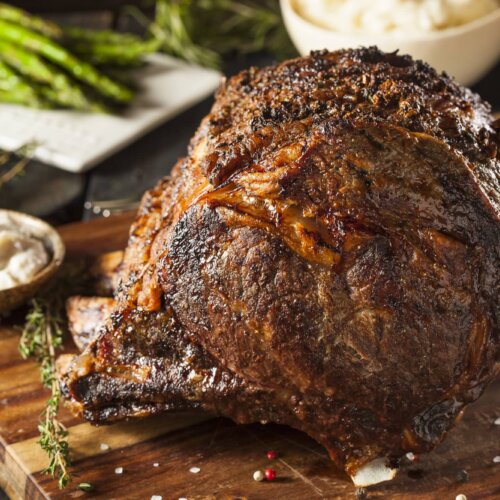
Grilled Prime Rib Roast
Ingredients
- 4-6 lb bone-in or boneless prime rib roast
- 2 tbsp Kosher salt
- 2 tbsp olive oil
- 1 tbsp ground black pepper
- 1 tbsp garlic powder
- 1 tbsp onion powder
- 2 tsp dried rosemary
Instructions
- Trim the prime rib by reducing the fat cap to about ¼ inch thick and removing any silverskin
- Sprinkle the roast with salt. Leave at room temperature for about 30 minutes.
- Coat the roast with oil, followed by a mixture of the black pepper, garlic powder, onion powder, and rosemary.
- Preheat your grill using indirect heat. If using a charcoal grill, set the coals on one side. For gas or pellet grills, heat to around 250°F.
- Place the roast on the grill over indirect heat. Close the lid and cook for 15-20 minutes per pound, or until the internal temperature reaches 125°F for medium-rare (it will rise in temperature as it rests). Rotate the roast occasionally when cooking to help it cook more evenly.
- Move the roast to direct heat to sear for about 3-5 minutes on each side.
- Rest the roast at room temperature for 15-20 minutes before carving it.

